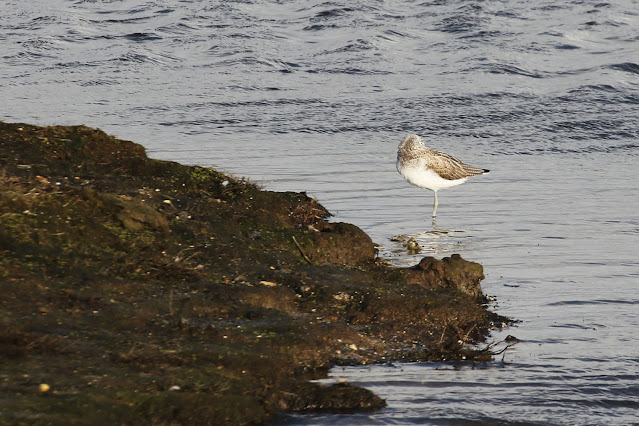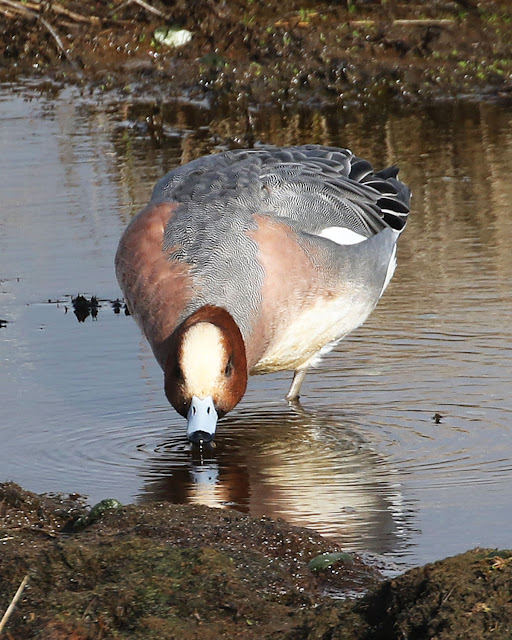The days are really getting longer now, which means an early start to arrive anywhere by sun rise. Today I was meeting Ian at the Lower Pennington Lane car park, the first time the two of us had been here this year. The early morning was clear with some distant cloud to the east blocking the rising sun, there was also quit a fresh westerly breeze. As we sorted ourselves out before heading off, the Little Egrets were just coming out of the roost and heading out towards the Keyhaven lagoons.
We headed across the Old Tip, taking the western side alongside Fishtail Lagoon. As the area of water became visible, through the early morning gloom a single Spoonbill could be seen feeding at the back of the lagoon.
It was an adult bird, the "spoon" bill showing the yellow orange colour at the tip and there was an orange patch on the throat.
It moved slowly away from us as we watched from the side of the lagoon so we decided to head to the sea wall where there was the chance that the light would be better and that it could be a little closer.
Looking west there was a very ominous build up of dark clouds, but with a dividing line that offered some hope it could miss us and we would stay dry
Walking below the reeds as we headed towards the sea wall the sun was beginning to break out of the clouds away to the east.
Up on the sea wall the tide was still high but beginning to fall, the waters of Fishtail Lagoon were high, probably as a result of the recent storms we had experienced. Here the spectacular clouds of the building storm away to the west look really impressive and reflected in the waters of the lagoon in this black and white photograph.
We walked towards the west and Keyhaven, on the marsh a Curlew watched us closely.
Looking back the sun was still fighting with the clouds to break through.
The Spoonbill was closer than when we first saw it and fortunately still active.
The rusty wash around the neck another feature of an adult bird going into breeding plumage.
Then it took off and flew past us for a short distance before settling on one of the small islands in the lagoon and disappeared from sight.
Once again the sky behind us was working up some magical scenes.
Then the Spoonbill was off again, this time coming straight towards us.
It passed overhead and then carried on in the direction of Keyhaven Lagoon.
It dropped down at the back of the Lagoon and at first we thought it had joined two others, but as we walked closer we could see these were in fact Little Egrets, the Spoonbill had also disappeared.
From Keyhaven we turned back and with the fresh wind on our backs we made our way back to Fishtail. The sun was now out and was lighting up the duck on saltmarsh. There are still plenty of Pintail around the area.
On the marsh alongside Keyhaven a splendid drake Wigeon in the sunshine.
And an Oystercatcher, quiet and still for once.
Scanning across the marsh found the two Peregrines sat on the beach, always a constant threat to the waders and wildfowl around them, but then its not the Peregrine you can see that is the problem.
Moving on to Fishtail, a pair of Shoveler in the flooded grassland.
And another beautiful drake Pintail.
Away to the south and west the skies were now a deep dark grey, the colour enhanced by the morning sunshine. Rainbows were appearing and it was very clear that we were escaping some heavy down pours. It was also opportune when three Mute Swans flew over, the dark skies providing the perfect background for the white plumage.
A Pipit flew across the channels and into one of the gullies, at first I though there was a chance it could be a Water Pipit, but getting a closer view it was clear this was a Rock Pipit.
The storms moving north around us were providing some very dramatic skies in both colour and black and white, here looking west towards Hurst Castle and the Needles.
And here looking across Fishtail Lagoon towards Keyhaven.
On the small piece of land between the lagoon and the stream Wigeon were sheltering from what was now quite a strong breeze.
We continued on around Butts Bay and to the point, looking back another rainbow was arching away across the dark grey skies.
Looking across the Solent towards Hurst Castle the dividing line between the calm and the storm was ever more clearer.
The sunlight across the reed bed of Butts Lagoon accentuated by the black and white conversion, while the dark cloud rumble on.
Looking away towards the calm the waders were moving around the islands and exposed mud and rocks as the tide fell.
We walked on, heading east towards Oxey and eventually Normandy Marsh. I picked up a Great Black-backed Gull on one of its searching flights, they can be seen cruising around the area, constantly scanning for any opportunity below. They are much more evident in the breeding season, which is not the far away now. With this in mind some of the Black-headed Gulls were prepared to mob the larger gull, but it seemed to treat them with distain.
A group of four very white gulls against the dark skies caught my eye and as they came closer it became clear that they were Mediterranean Gulls, the perfect snowballs against the dark skies.
Passing Jetty Lagoon the reeds continued to look even more dramatic in black and white.
A pair of Shoveler sleeping away the morning in the flooded vegetation on Jetty Lagoon.
From first light there had been good numbers of Little Egret about, they seemed to be everywhere. This individual had just been chase off by another on the Pennington Lagoon.
A little further along a Greenshank and Spotted Redshank were feeding together in one of the lagoon's bays. Both are happy to feed in deeper water and both have a similar feeding style that relies and sight and lightning fast reflexes.
A Greenshank resting in the shallower water.
Wigeon flying into the lagoon from the marsh, constantly whistling to maintain contact.
A Cormorant
There are two species of cormorant breeding in the UK. A
‘continental’ subspecies P.c.sinensis and the ‘coastal’ P.c.carbo. P.c.sinensis
has pioneered the way into breeding inland in trees and P.c.carbo is following
closely behind. Now I always though the way to identify the sinensis subspecies was by the extensive white feathering you see here, but apparently the way to differentiate between the two is to look at the gular
pouch. This is the yellow-orange area of skin at the base of the lower
mandible; its purpose is to dissipate heat away from the Cormorant’s body.
Cormorants with a gular pouch angle of less than 65 degrees
are P.c.carbo, while those greater than 76 degrees are P.c.sinensis. Looking at the pouch in this bird the angle isn't good, so I am not sure if it could be said to be sinensis. Anyway after fishing for a while it flew off
Walking around to the lagoons alongside Oxey Marsh there was another Greenshank, this time in stiller water which was providing a nice reflection.
It was joined by a Common Redshank providing a nice comparison of the two wader species.
The Greenshank moving away from the Redshank. They are another of those lovely photogenic waders, especially if there is a dark background which is what the still waters of the lagoon were providing.
As we watched the Greenshank, a Raven came along the edge of the lagoon side and passed so close to us at one point it was too close for the camera.
Walking around to the lagoon that runs alongside the path heading north there was a group of Wigeon standing in the shallow pools. One drake was drinking from the pool and the light was showing off the grey and pink of his plumage so well.
The wigeon is a highly gregarious bird species. In their
non-breeding range, these ducks form closely packed social groups. In the
winter season, many birds flock together to while in the breeding season, their
close aggregations disperse and they nest only in pairs. The Wigeon is monogamous, sticking with the
same mate through out their lives.
Wigeon communication occurs mainly by vocalizations. A male
makes a high-pitched whistle while females call making a deeper growl.
The name “Wigeon” probably comes from the Middle French “vigeon
or from the Old French vignier which means “to whine or shout”, most likely a
reference to constant whistling of the ducks when they are in their close
flocks on the marshes
We walked on and crossed Moses Dock and walked alongside the Salterns ponds. A Kingfisher broke from the trees and disappeared strangely across the open grassland. The dramatic skies were still with us, once again the trees and reeds providing highlights in the black and white image.
You will have probably noticed the title of this post sates Part One and this is where the story of the day ends for now. What happened next will follow shortly. It always seems that this reserve delivers on quality birds and photographic opportunities.



































































No comments:
Post a Comment